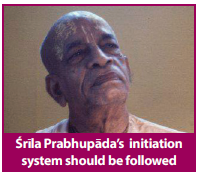
Back To Prabhupada, Issue 46, Winter 2014/15
rila Prabhupada's directive of July 9th, 1977, allowed Srila Prabhupada to remain ISKCON's diksa guru even in his physical absence, via representatives authorised to conduct initiations on his behalf. The GBC has argued that such a system whereby Srila Prabhupada remains ISKCON's diksa guru is not possible since it would mean overturning all that Srila Prabhupada had taught in his books (the quote below refers to this rtvik system):
"In conclusion, it is very hard for those who knew Prabhupada and his consistency of teaching, or for that matter anyone who has made a thorough study of his books, to accept that Srila Prabhupada intended his followers to completely overturn all of his voluminous teachings."
(Prabhupada's Order, GBC, 1998)
Hence, it is argued that Srila Prabhupada would not spring a "new" system of initiation on ISKCON just before his departure.
Below we examine the evidence for what Srila Prabhupada taught in his books, and who is actually introducing a new system of initiation.
In his books, Srila Prabhupada gives the system that generally determines who becomes the diksa guru:
"Generally a spiritual master who constantly instructs a disciple in spiritual science becomes his initiating spiritual master later on."
(Cc., Adi-lila, 1.35)
"[...] generally the siksa-guru later on becomes the diksa-guru."
(SB, 4.12.32)
Thus, normally the person who instructs a disciple as a siksa guru goes on to become his diksa guru.
Srila Prabhupada does, however, specifically state an exception to this general system being followed:
"Suniti, however, being a woman, and specifically his mother, could not become Dhruva Maharaja's diksa-guru."
(SB, 4.12.32)
But Srila Prabhupada does not go on to state the following "departure exception" for this system anywhere in his teachings:
"The siksa guru, however, not being physically present, can not become a diksa guru."
In his books, Srila Prabhupada states the system of initiation to be followed in ISKCON:
"Due to the necessity of these activities, we do not immediately initiate disciples in the International Society for Krishna Consciousness. For six months, a candidate for initiation must first attend arati and classes in the sastras, practice the regulative principles and associate with other devotees. When one is actually advanced in the purascarya-vidhi, he is recommended by the local temple president for initiation."
(Cc., Madhya-lila, 15.108)
Srila Prabhupada explains that as soon as one joins ISKCON, they attend classes in the sastra (scripture), and after 6 months they are initiated upon recommendation by the temple president. During Srila Prabhupada's physical presence, all these classes were based entirely on Srila Prabhupada's teachings, with the classes consisting of readings and discussions of only Srila Prabhupada's books. And then the subsequent initiation always resulted in the candidate accepting Srila Prabhupada as his diksa guru. Hence, the person from whom one initially learned about the teachings of Krishna consciousness -- Srila Prabhupada -- went on to become one's diksa guru. In this way, the system also tallied with the normal guru system described in Srila Prabhupada's books, quoted in the previous section.
And, since here Srila Prabhupada describes the initiation system to be followed in ISKCON in his books, it must be followed in ISKCON at all times, since his books are also applicable within ISKCON for all time. And, as this system resulted in the recommended candidate automatically becoming a disciple of Srila Prabhupada after 6 months, the same result must also occur at all times in ISKCON. Indeed, this system as described cannot result in one becoming initiated by anyone other than Srila Prabhupada. For the system does not make provision for a candidate to start associating with and searching for another diksa guru after the initial 6-month training period under Srila Prabhupada's teachings is completed, as occurs under the current GBC system. Hence, Srila Prabhupada can be the only possible person by whom one can become initiated under the system described in Srila Prabhupada's books as being the initiation system for ISKCON.
And we noted in the last section that Srila Prabhupada has not given any "departure" exception that would prevent this system from continuing to be applied in ISKCON at all times.

However, instead of following the initiation system given by Srila Prabhupada in his books, the GBC has invented a system which has a management committee voting in dozens of diksa gurus who are subordinate to them. The GBC states that this system is new since:
1) It is not based on guru, sadhu and sastra:
"Our present system has institutionalized a process of senior devotees voting or offering no-objection to prospective gurus. But we do not find that this institutionalized blessing seeking process is mentioned by guru, sadhu or sastra as the way that one is authorized to become a guru."
(Balancing the Roles of the GBC and the Disciple in Guru Selection, "sastric Advisory Committee to the GBC")
2) It has no basis in Vaisnava tradition:
"[...] the idea of this GBC is not exactly traditional [...] when you're going to have a single institution with many different spiritual masters and there are many different disciples who are going to have to work together in a cooperative and unified way. Just hadn't been done."
(HG Ravindra Svarupa Dasa, GBC member, Lecture, 29/6-3/7/99)
3) And, as a simple examination will reveal, we can note that it was never ordered by Srila Prabhupada either in his books or anywhere else.
We have a choice between:
1) Following Srila Prabhupada's initiation system.
2) Manufacturing a new initiation system not given by Srila Prabhupada.
Followers of Srila Prabhupada will choose his system. However, the GBC decided to manufacture their own new system.
Return to IRM Homepage